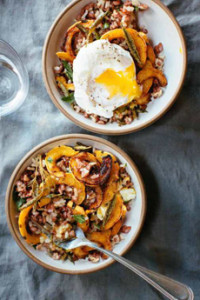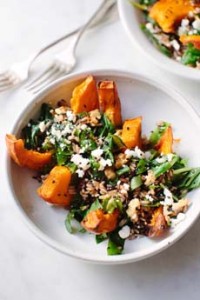TIP OF THE DAY: Grain Bowls With Roasted Vegetables
|
|
Did grain bowls originate in healthy “salad” food chains? All we know is that in the last few years, grain bowls have become a go-to light and nutritious meal, whether you buy yours from a food shop or bring it from home.
Make one of your new year healthy food switches a weekly grain bowl. The options are endless, and you’ll get to try different grains and explore other ingredients, including different varieties of squash. (Squash and grains are a great marriage.) Grain bowls can be served at lunch or dinner; hot, warm, or chilled. They can be: No time to cook grains? Look at precooked grains; add or substitute canned beans. Check out the recipe below. The formula is simple: cooked grain topped with vegetables and proteins, drizzled with dressing, and garnished. |
|
|
RECIPE: WILD RICE & ROASTED SQUASH SALAD This recipe, from Good Eggs, takes 15 minutes of prep time and 30 minutes of cook time. It specifies kabocha squash; but as mentioned above, you can take the opportunity to try any squash you like. Ingredients *The difference between beans and legumes: All beans are legumes, plants with pod fruits. But the category also includes peas, pulses (like lentils), and even pod-based vine nuts like peanuts. 1. PREHEAT the oven to 400°F. Using a sturdy knife and a steady hand, cut the squash in half and scoop out the seeds. (Save ‘em to roast if you like!) Slice kabocha halves into 1” thick wedges and arrange them in one layer on a baking sheet. Toss with a pinch of salt and a bit of olive oil—just enough to coat each piece—and place the sheet in the oven. They should take about 30 minutes to cook. 2. PUT the rice in a pot with 2 cups of water and bring it to a boil. When the water boils, cover the pot and turn it down to a simmer until the rice is cooked (about 25-30 minutes). While the rice and the squash cook… 4. CHECK the rice. If it’s fully cooked, turn off the flame and let it sit for a few minutes in the covered pot. If all of the water is absorbed but the grains are not yet cooked, add a bit more water and continue to cook it with the cover on for a few more minutes. When it’s done, scoop the rice into a bowl and place it in the fridge for a few minutes. 5. CHECK the squash. When it is fully cooked (golden brown and tender) after about 30 minutes, remove it from the oven. Let it cool slightly if you don’t want to wilt the greens. In a bowl, combine the rice, squash, greens, sesame seeds, parsley, walnuts, and feta. Dress with a couple splashes of rice vinegar, a bit of olive oil, and a few drops of sesame oil. Mix gently with a large spoon. 6. ADJUST seasonings (salt and pepper) to taste and serve. |
||
|
A SQUASH ODYSSEY
What do these have in common: acorn, Australian blue, banana, buttercup, butternut, calabaza, carnival, chayote, delicata, gold nugget, hubbard, kabocha, orangetti, red kuri, spaghetti, stripetti, sweet dumpling, and turban? They’re all winter squash—but you probably guessed that from the headline. Do you know how delicious they all are, though? We went on a two-week squash odyssey and found a personal favorite (carnival squash, so good we ate the rind; sweet dumpling squash was our runner-up). Squash Is A Guilt-Free Food Read more about these gorgeous vegetables in our Squash Glossary. Kabocha is also called Japanese pumpkin, especially in Australia and New Zealand. It is the variety of squash used in tempura. You may find different varieties in farmer’s markets. We’ve included photos of three varieties. Many of the kabocha in the market are kuri kabocha, a variety bred from seiyo kabocha, buttercup squash. It has a strong yet sweet flavor; its texture and flavor have been described as a combination of pumpkin and sweet potato. The rind of a kabocha is edible. Kabocha is available year-round but peaks in the late summer and early fall. Squash History The ancestors of all squash originated, and were domesticated, in Mesoamerica, some 8000 to 10,000 years ago. That’s 4,000 years earlier than the domestication of maize and beans, other local staples. Christopher Columbus brought squash back to Europe, along with tobacco, potatoes, and tomatoes. From there, the vegetable was dispersed around the world. |
|
|
|
In 1541 squash was brought to Japan from Cambodia on Portuguese ships. The sailors then went to Japan, where they introduced the squash as Cambodia abóbora, (Cambodian pumpkin). The name was shortened by the Japanese to kabocha, and kabocha became the generic term for all squash. [Source]
|
||




